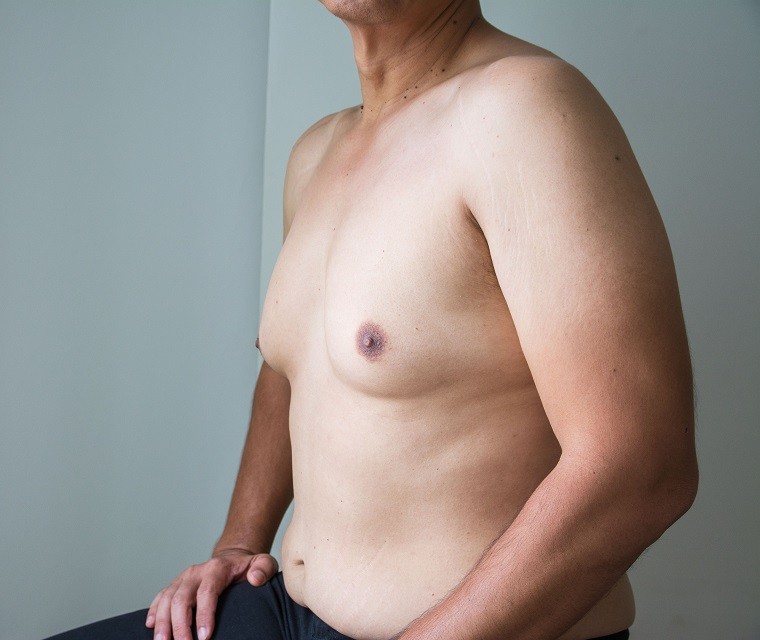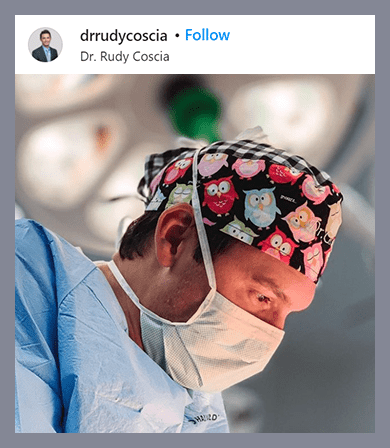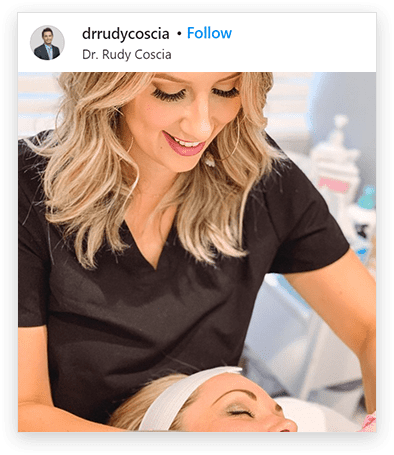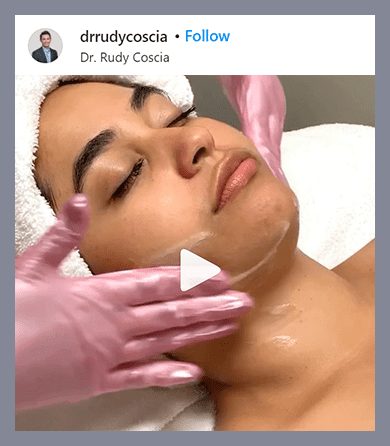
Gynecomastia Surgery
in Sacramento, Granite Bay & Coeur d’Alene
Some men develop enlarged glandular breast tissue due to factors like hormonal imbalance or drug and medication use. Those who dislike having more “feminine” chest contours may seek a cosmetic or surgical solution. Dr. Rudy Coscia, a board-certified plastic surgeon, performs gynecomastia (or male breast reduction) surgery to help his patients achieve a more manly physique. Before scheduling the surgery, he will examine the potential causes of the enlarged tissue to determine if a non-surgical solution may be more appropriate.
In cases of true gynecomastia, prior to considering surgical intervention, a medical workup is needed that can be guided by your primary care physician or further discussed with Dr. Coscia. Enlargement of the breasts in a male obviously causes issues with self-confidence and body image. Therefore, after other medical causes of male breast enlargement have been ruled out, surgical intervention may be a very good treatment option.
Home » Gynecomastia
Benefits of Male Breast Reduction
Men who have male breast reduction enjoy:
- A more traditionally masculine physique
- Enhanced confidence and self-image
- Improved ability to exercise
- Better clothing options like fitted shirts
- Long-lasting results
Candidates for Male Breast Reduction
 Male breast reduction surgery is a good option for many men with enlarged breast tissue, though Dr. Coscia may first suggest other options depending on the root cause of the problem.
Male breast reduction surgery is a good option for many men with enlarged breast tissue, though Dr. Coscia may first suggest other options depending on the root cause of the problem.
Many teenage boys develop gynecomastia during puberty due to fluctuating hormones, but in most cases the symptoms subside within a year or two without the need for surgery. Some men see improvement by losing weight with a deliberate diet and exercise plan. Others develop gynecomastia while taking certain types of medication and finding that switching prescriptions (when a doctor supervises and approves) can alleviate the symptoms.
After other causes and solutions have been ruled out, Dr. Coscia can assess a patient’s candidacy for the procedure during a consultation, taking into account any relevant health factors.
Home » Gynecomastia
Gynecomastia Surgery Procedure Details
Each patient with male breast enlargement issues is approached differently, as the patterns of male breast enlargement can vary in presentation quite dramatically. Some patients have a slight fullness underneath the nipple. Other patients have a generalized fullness throughout the breast. Still, others may have a combination of the above with the addition of excess loose breast skin. During your consultation, Dr. Coscia will perform a physical exam and describe treatment options in your specific case. These surgical interventions can include liposuction, excision of breast tissue, or a combination of both liposuction and excision.
Home » Gynecomastia
Male Breast Reduction Recovery
Male breast reduction is an outpatient procedure. Patients should prioritize rest and relaxation for the first week while at home. Dr. Coscia can prescribe pain medication to manage any post-surgical discomfort. Most patients feel well enough to return to work within a week or two, though they should continue to wear the compression garment provided by Dr. Coscia to accelerate healing and lower the risks of infection and swelling for about six weeks.
Male Breast Reduction Results
Though the patient’s chest is visibly smaller immediately following surgery, it can take several months for the full results to manifest after surgery. In most cases, these results are considered indefinite. Patients who maintain a steady weight after their surgery should be able to enjoy their flatter, slimmed-down chest throughout their lives. However, it is possible for other factors like medication or hormone fluctuations to cause the breast tissue to enlarge again.
Gynecomastia Surgery Costs
Because gynecomastia is considered a cosmetic issue foremost, it is not covered by most health insurance plans. The total price of male breast reduction depends on the approach Dr. Coscia uses to correct and remove the glandular tissue. He can discuss specific costs during a consultation so that you may make a fully informed decision. Financing options are available.
Scars, Lumps & Puffiness
Home » Gynecomastia
Male Breast Reduction Frequently Asked Questions
At what age does gynecomastia occur?
Although gynecomastia occurs most frequently in teenage boys and older men, patients of all ages have been diagnosed with the condition, from newborns to senior citizens.
Can I cure gynecomastia with exercise?
If fat is the reason that you have an enlarged chest, then it is probably possible to address this problem area by losing weight. However, if you have true gynecomastia (caused by dense glandular tissue), losing weight will not affect the condition. In this case, male breast reduction surgery is the most effective solution for improving the chest’s appearance.
Will I have scars after gynecomastia?
Because incisions are necessary when Dr. Coscia performs male breast reduction, scarring is inevitable. Fortunately, Dr. Coscia is careful to place these incisions along the natural lines and contours of the body where they are easily concealed. Ultimately, most patients are so happy to have a more masculine-shaped chest that having faded scars seems like a worthwhile trade.
What Type of Anesthesia is Used for this Procedure?
Most commonly, general anesthesia is used for male breast reduction surgery. On occasion, IV sedation with the injection of local anesthetic may be used in small cases.
What are some of the causes of gynecomastia?
The most common cause is a hormonal imbalance between estrogen and testosterone, where elevated estrogen levels or reduced testosterone levels contribute to the development of glandular breast tissue. This imbalance can occur naturally during puberty, aging, or because of medical conditions such as hypogonadism, hyperthyroidism, or liver disease.
Certain medications can also contribute to gynecomastia, including anabolic steroids, anti-androgens (used for prostate conditions), some antidepressants, anti-anxiety medications, and even heartburn drugs. Additionally, lifestyle factors such as excessive alcohol consumption, recreational drug use (particularly marijuana), and obesity can contribute to gynecomastia. Understanding the underlying cause is important in determining the best treatment approach.
Is it possible for gynecomastia to go away on its own?
In some cases, gynecomastia may resolve naturally without the need for surgical intervention. For example, many adolescent boys experience temporary gynecomastia due to hormonal fluctuations during puberty, and in most cases, the condition improves within a few months to a couple of years.
However, when gynecomastia persists into adulthood or is caused by factors like medication use, obesity, or underlying medical conditions, it is less likely to resolve on its own. Weight loss may reduce the appearance of gynecomastia if excess fat is a contributing factor, but true gynecomastia involves glandular tissue that does not respond to diet or exercise. In such cases, male breast reduction surgery may be the most effective solution.
How long is gynecomastia surgery?
Gynecomastia surgery, or male breast reduction, typically takes about one to two hours, depending on the complexity of the case. The procedure is performed under general anesthesia on an outpatient basis, meaning patients can return home the same day.
Can gynecomastia come back after male breast reduction surgery?
 For most patients, the results of gynecomastia surgery are permanent because the excess glandular tissue is surgically removed and does not regenerate. However, certain factors can lead to a recurrence of gynecomastia. Significant weight gain can result in an increase in fat accumulation in the chest, which may create the appearance of gynecomastia. Additionally, hormonal imbalances, steroid use, or certain medications could stimulate new breast tissue growth.
For most patients, the results of gynecomastia surgery are permanent because the excess glandular tissue is surgically removed and does not regenerate. However, certain factors can lead to a recurrence of gynecomastia. Significant weight gain can result in an increase in fat accumulation in the chest, which may create the appearance of gynecomastia. Additionally, hormonal imbalances, steroid use, or certain medications could stimulate new breast tissue growth.
How can a doctor tell the difference between true gynecomastia and chest fat?
During a physical exam, glandular tissue typically feels firm and rubbery, whereas fat deposits are softer and more diffuse. Additionally, true gynecomastia often involves a concentrated mass beneath the nipple, which can be tender or sensitive. If the diagnosis is unclear, imaging tests like ultrasound or mammography may be recommended. True gynecomastia often requires surgical removal of glandular tissue, while chest fat can often be treated with liposuction alone.
Why should I choose Dr. Coscia for gynecomastia surgery?
Dr. Rudy Coscia is a board-certified plastic surgeon with extensive experience in body contouring and male breast reduction procedures. His expertise in advanced surgical techniques allows him to create natural, well-sculpted results tailored to each patient’s unique anatomy. His approach focuses on minimizing scarring, achieving masculine chest contours, and delivering long-lasting results. Schedule a consultation to see for yourself why he is considered one of Sacramento’s top plastic surgeons.
Learn More About Male Breast Reduction
If you are concerned by male breast enlarged tissue, call and schedule a consultation with Dr. Coscia to talk about surgical treatment options. He can also direct further medical evaluation if necessary.
Dr. Coscia’s practices also serve Coeur d’Alene, ID, and the Rocklin and Loomis areas. Please fill out the form on this page to request a consultation or call our call his Granite Bay (916) 249-2863 or Sacramento (916) 318-5826 locations to request a consultation today.
*Individual results may vary













